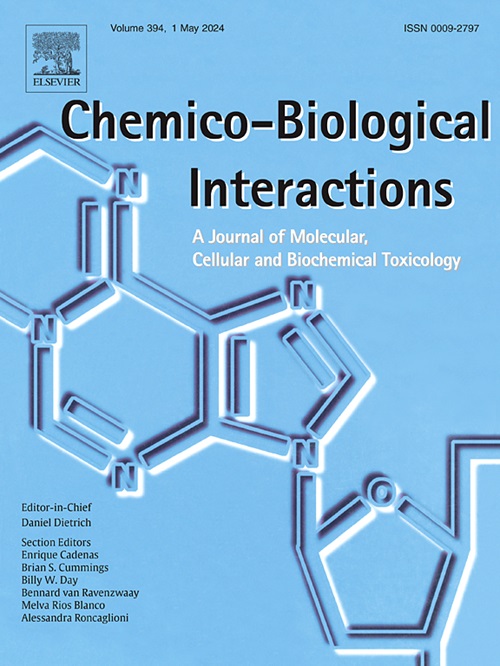玉米霉烯酮通过全局和基因特异性组蛋白修饰和mirna介导的p53信号通路对内质网应激诱导凋亡的影响
IF 4.7
2区 医学
Q1 BIOCHEMISTRY & MOLECULAR BIOLOGY
引用次数: 0
摘要
玉米赤霉烯酮(ZEA)是一种由镰刀菌产生的非甾体雌激素性真菌毒素,以其强大的雌激素样作用而闻名,可导致生殖毒性和各种器官毒性。虽然有几项研究报道了其肾毒性作用,但zea诱导毒性的分子机制仍然知之甚少。本研究研究了ZEA对人胚胎肾上皮细胞(HEK-293)暴露于1-50 μM ZEA环境24 h后凋亡和内质网(ER)应激相关基因、染色质修饰酶编码基因、肿瘤通路相关miRNA谱和全局组蛋白修饰(H3K4me3、H3K9me3、H3K27me3和H3K9ac)表达水平的影响。结果表明,10和50 μM ZEA通过上调Bcl-2、CASP3, CASP9和p53。内质网应激相关基因,如GRP78、PERK、ATF4、IRE2、CHOP和eIF2α的表达水平的改变可能有助于zea诱导的毒性。染色质修饰酶编码基因EZH2、G9a、HAT1、RIZ1、SETD1A、SIRT1和DNA甲基化相关基因DNMT1、DNMT3A、DNMT3B的表达水平未见明显变化。而SETD8和Suv39h1在50 μM的ZEA下表现出明显的变化。此外,在50 μM ZEA暴露24小时后,全球组蛋白修饰水平显著降低。染色质免疫沉淀(ChIP)结果显示,在ZEA暴露后,ATF4、CHOP、Bcl-2和p53基因上的H3K27me3、H3K9me3和H3K9ac修饰发生了显著变化。miRNA阵列分析显示,几种miRNA的表达水平显著降低。这项综合研究的结果有望对阐明ZEA毒性作出重大贡献。本文章由计算机程序翻译,如有差异,请以英文原文为准。
Effects of zearalenone on endoplasmic reticulum stress-induced apoptosis via global and gene-specific histone modifications and miRNA-mediated p53-signaling pathway in HEK-293 cells
Zearalenone (ZEA), a non-steroidal estrogenic mycotoxin produced by Fusarium species, is well-known for its potent estrogen-like effects, which can lead to reproductive toxicity and toxicity in various organs. Although several studies have reported its nephrotoxic effects, the molecular mechanisms underlying ZEA-induced toxicity remain poorly understood. The present study investigates the effects of ZEA on the expression levels of apoptosis and endoplasmic reticulum (ER) stress-related genes, as well as selected chromatin-modifying enzyme coding genes, miRNA profiles associated with cancer pathways, and global histone modifications (H3K4me3, H3K9me3, H3K27me3, and H3K9ac) in human embryonic kidney epithelial (HEK-293) cells exposed to 1–50 μM ZEA for 24 h. The results indicated that 10 and 50 μM ZEA induced apoptosis through upregulating Bcl-2, CASP3, CASP9, and p53. Alterations in the expression levels of ER stress-related genes, such as GRP78, PERK, ATF4, IRE2, CHOP, and eIF2α, could contribute to ZEA-induced toxicity. No significant changes were observed in the expression levels of chromatin-modifying enzyme coding genes, including EZH2, G9a, HAT1, RIZ1, SETD1A, and SIRT1, DNA methylation-related genes such as DNMT1, DNMT3A, and DNMT3B. However, SETD8 and Suv39h1 exhibited significant changes at 50 μM of ZEA. Moreover, global histone modification levels significantly decreased at 50 μM ZEA exposure for 24 h. Chromatin immunoprecipitation (ChIP) results revealed significant changes in H3K27me3, H3K9me3, and H3K9ac modifications on the ATF4, CHOP, Bcl-2, and p53 genes following ZEA exposure. miRNA array analysis showed notable and significant reductions in the expression levels of several miRNAs. The results obtained from this comprehensive study are expected to make a significant contribution to the elucidation of ZEA toxicity.
求助全文
通过发布文献求助,成功后即可免费获取论文全文。
去求助
来源期刊
CiteScore
7.70
自引率
3.90%
发文量
410
审稿时长
36 days
期刊介绍:
Chemico-Biological Interactions publishes research reports and review articles that examine the molecular, cellular, and/or biochemical basis of toxicologically relevant outcomes. Special emphasis is placed on toxicological mechanisms associated with interactions between chemicals and biological systems. Outcomes may include all traditional endpoints caused by synthetic or naturally occurring chemicals, both in vivo and in vitro. Endpoints of interest include, but are not limited to carcinogenesis, mutagenesis, respiratory toxicology, neurotoxicology, reproductive and developmental toxicology, and immunotoxicology.

 求助内容:
求助内容: 应助结果提醒方式:
应助结果提醒方式:


